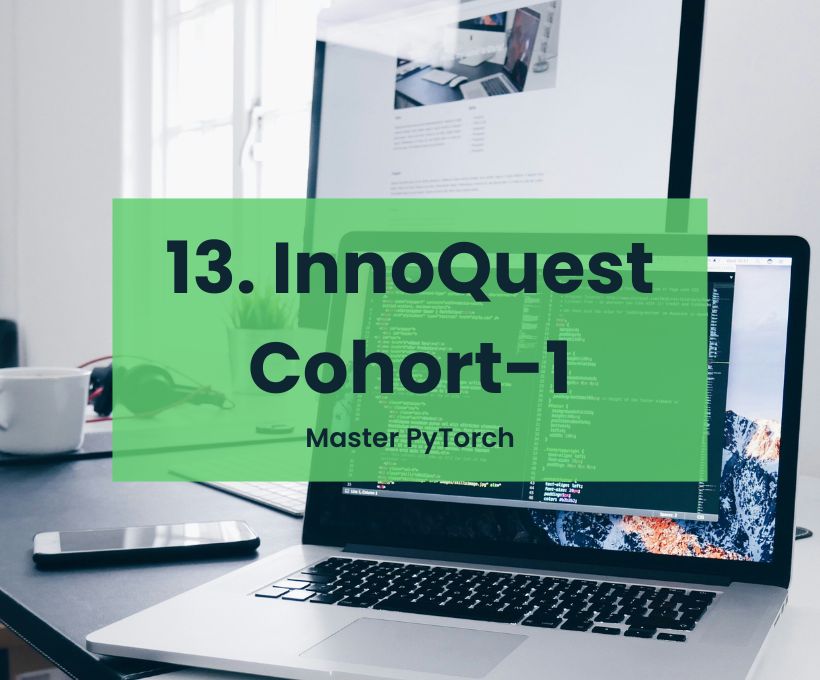Table of Contents
- Introduction
- Why PyTorch Over TensorFlow?
- Exploring Tensors in PyTorch
- Advanced Tensor Operations
- PyTorch’s GPU Capabilities
- Building Custom Models with PyTorch
- Lessons Learned and Insights
- Let’s Collaborate
1. Introduction
InnoQuest Cohort-1 has been an incredible journey for me, offering deep insights into AI and ML practices. Class 13, in particular, stood out as a game-changer where we explored the fundamentals of PyTorch and its practical applications. This blog captures my experience and key learnings from this session, providing value to recruiters, clients, and fellow AI enthusiasts.
2. Why PyTorch Over TensorFlow?
One of the first discussions in the class revolved around the advantages of PyTorch compared to TensorFlow. PyTorch’s dynamic computation graph makes it more intuitive and flexible for research-oriented tasks, while TensorFlow is often favored for production-grade systems. For a learner and experimenter, PyTorch’s ease of debugging and interactive approach is unparalleled.
3. Exploring Tensors in PyTorch
Creating Different Tensors
We started by creating various tensors to get familiar with the building blocks of PyTorch:
- Empty Scalar Tensor: A tensor with no dimensions.
- 2D and 3D Tensors: For matrices and volumetric data.
- Random-Value Tensor: A tensor filled with random numbers.
- Custom-Value Tensor: A tensor initialized with specific values.
Reshaping and Type Conversions
Manipulating tensor shapes and converting data types became an enjoyable exercise. Reshaping tensors and observing how dimensions adjusted provided clarity on handling multi-dimensional data. I also explored converting tensors into NumPy arrays and vice versa.
4. Advanced Tensor Operations
Device Type and Shared Memory
We learned how to check the device type (CPU or GPU) of a tensor. A fascinating observation was that when using shared memory on the CPU, changes in a NumPy array automatically reflect in the tensor linked to it, and vice versa. This shared memory concept streamlines interoperability.
Slicing, Stacking, and Concatenation
- Slicing: Extracting portions of tensors.
- Stacking: Adding a new depth to the tensor.
- Concatenation: Joining tensors side-by-side without creating a new depth.
Understanding these operations deepened my grasp of how tensors work and their flexibility.
5. PyTorch’s GPU Capabilities
Switching tensors to GPU and performing operations on them was incredibly powerful. The seamless transition between CPU and GPU enabled a deeper understanding of PyTorch’s efficiency in handling computationally intensive tasks.
6. Building Custom Models with PyTorch
Creating a Custom Model
The session also delved into designing custom models. Using PyTorch’s modular approach, I built a model tailored to the problem at hand, gaining practical insights into neural network design.
Custom Data Loaders and Training
We worked with custom data loaders to preprocess and load data efficiently. Training a model on the Wine dataset was an intuitive and engaging experience, offering a complete cycle from data preparation to evaluation.
7. Lessons Learned and Insights
This session bridged the gap between theory and practice. While I had previously concentrated on ML concepts, understanding PyTorch tensors and their role in neural network design was profoundly enlightening. Key takeaways include:
- PyTorch’s ability to return new tensors instead of updating originals is a game-changer for debugging.
- The interplay between CPU and GPU enhances computation efficiency.
- Practical insights into creating and training custom models.
8. Let’s Collaborate
I’m excited to apply these learnings to real-world projects and help businesses leverage the power of AI and ML. Whether you’re a recruiter seeking a dedicated AI professional or a client looking for custom AI solutions, I’d love to connect and collaborate. Let’s build something impactful together.
Feel free to reach out to discuss opportunities. Together, we can innovate and excel in the field of AI and ML.
Thank you for taking the time to read about my experience. Stay tuned for more updates from the InnoQuest Cohort-1 training!
